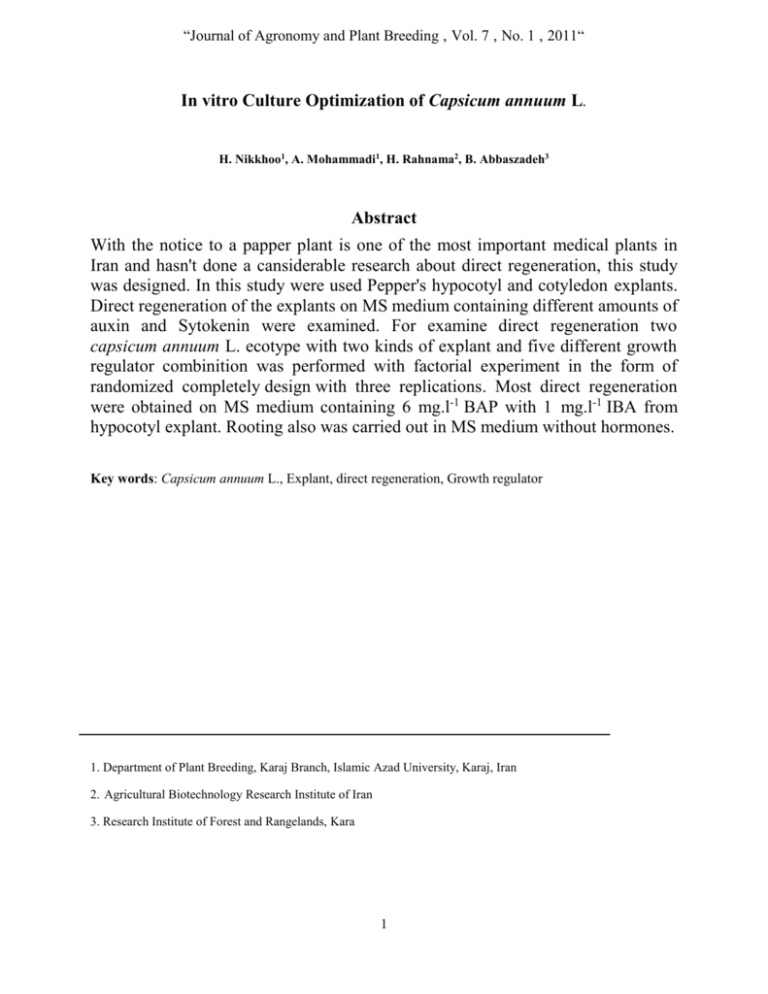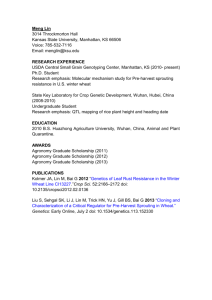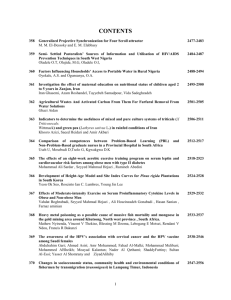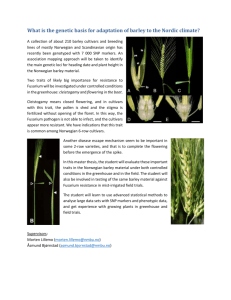Abstract
advertisement

“Journal of Agronomy and Plant Breeding ‚ Vol. 7 ‚ No. 1 ‚ 2011“ In vitro Culture Optimization of Capsicum annuum L. H. Nikkhoo1, A. Mohammadi1, H. Rahnama2, B. Abbaszadeh3 Abstract With the notice to a papper plant is one of the most important medical plants in Iran and hasn't done a cansiderable research about direct regeneration, this study was designed. In this study were used Pepper's hypocotyl and cotyledon explants. Direct regeneration of the explants on MS medium containing different amounts of auxin and Sytokenin were examined. For examine direct regeneration two capsicum annuum L. ecotype with two kinds of explant and five different growth regulator combinition was performed with factorial experiment in the form of randomized completely design with three replications. Most direct regeneration were obtained on MS medium containing 6 mg.l-1 BAP with 1 mg.l-1 IBA from hypocotyl explant. Rooting also was carried out in MS medium without hormones. Key words: Capsicum annuum L., Explant, direct regeneration, Growth regulator 1. Department of Plant Breeding, Karaj Branch, Islamic Azad University, Karaj, Iran 2. Agricultural Biotechnology Research Institute of Iran 3. Research Institute of Forest and Rangelands, Kara 1 “Journal of Agronomy and Plant Breeding ‚ Vol. 7 ‚ No. 1 ‚ 2011“ Reaction of some wheat commercial varieties and advanced lines to septoria tritici isolates M. A. Makhdomi1, R. Mehrabi2, M. Khodarahmi1, M. R. Bihamta3, S. J. Zad4 Abstract Septoria tritici blotch (STB), caused by the ascomycete Mycosphaerella graminicola is a hetrotalic bipolar fungi which in some part of Iran cause economic loss periodically. In this experiment reaction of 43 genotypes contain 25 tetraploid advance lines and 18 commercial bread wheat cultivars to 6 Iranian isolates under greenhouse condition was evaluated at the seedling stage in two separate experiments. Significance Results of genotype × isolate interaction indicated the different between isolates and the different reaction of genotypes to M.graminicola isolates. Results of the reaction of genotypes to isolates showed that most of tetraploid lines and commercial hexaploid wheat are susceptible to isolates and there is some specific reaction between some genotypes and isolates, in this study Marvdasht commercial bread wheat cultivar was known as a high resistant hexaploid cultivar and Aria as a tetraploid wheat. Key words: Septoria tritici bloth, commercial coultivar, seedling stage 1- Department of plant breeding, Karaj branch, Islamic Azad University, Karaj, Iran 2- Seed and plant improvement institute 3- Department of plant breeding, University of Tehran 4- Department of plant pathology, University of Tehran 2 “Journal of Agronomy and Plant Breeding ‚ Vol. 7 ‚ No. 1 ‚ 2011“ Evaluation of barley tolerant genotypes to drought stress in Karaj region A. Afzalifar1 , M. Zahravi2, M. R. Bihamta3 Abstract In order to evaluation and identification of tolerant Iranian Hordeum spontaneum genotypes to drought stress in Karaj region this research were conducted in farm of Karaj seed and plant improvement institute. Effects of two different irrigation treatment were done in Karaj using randomize complete block design in 3 replications in one year. Irrigation treatments were under normal and drought stress condition. The results of simple variance analysis in normal condition showed significant different between plant height, number of grain, biomass, spike length and harvest index indices. In addition, genotypes in number of grain, grain yield and spike height traits had significant difference between drought stress conditions. In both condition genotype × environment interaction in plant height, biomass, spike length and grain yield had significant difference that showed genotypes to irrigation condition had difference reaction. All of the traits except harvest index in both condition showed positive and significant correlation with grain yield. Keywords: Iranian Hordeum spontaneum, drought stress, traits correlation 1 - Department of plant breeding, Karaj branch, Islamic Azad University, Karaj, Iran 2 - Research Seed and Plant Improvement institute, Karaj, Iran 3 - Department of plant breeding, University of Tehran 3 “Journal of Agronomy and Plant Breeding ‚ Vol. 7 ‚ No. 1 ‚ 2011“ Callusogenesis investigation of lemon balm (Melissa officinalis L.) M. M. Soltani pool1, A. Mohammadi1, H. Rahnama2, B. Abbaszade3 Abstract In this research callus induction under in vitro condition in medicinal plant, lemon balm (Melissa officinalis L.) has been considered as a preliminary method for modification of this plant. For this purpose factorial expriment based on completely randomize design has been used with factors, ecotype (Isfahan and Karaj), origin of explant (leaf, petiol, internode), Lighting conditions (light and dark), 2, 4-D (0, 0.5, 1, 2 mg/l) and BAP (0, 1, 2 mg/l) with three replications. Results showed that the best hormonal treatment for callus induction in lemon balm was 1mg/l 2, 4-D + 1mg/l BAP for internodes and petiole in light condition. After that, use of leaf explants with 0.5mg/l 2, 4-D + 1mg/l BAP in dark and then light condition was the best. Key words: Lemon balm, Callus, 2, 4-D, BAP 1- Department of plant breeding, Karaj Branch, Islamic Azad University, Karaj, Iran 2 - Agricultural Biotechnology Research Institute of Iran 3- Research Institute of Forest and Rangland, Karaj, Iran 4 “Journal of Agronomy and Plant Breeding ‚ Vol. 7 ‚ No. 1 ‚ 2011“ Study on resistance of wheat commercial cultivars to yellow rust to some isolates (Puccinia striiformis f. sp. tritici) from different regions of Iran A. Omrani1 , M. Khodarahmi 1, F. Afshari 2 Abstract To breed for resistant cultivars of wheat to yellow rust disease, it is necessary to determine characteristic of the disease pathosystem pathogencity. In this study virulence factors was determined of six pathotypes of yellow rust that has been collected from regions Zarghan, Gorgan, Ardebil, Mamasani, Sari, Hamedan with using from Standard set and near Isogenic lines of wheat yellow rust. Also resistance of some wheat commercial cultivars was evaluated with that pathotypes. Experimenter materials in seedling stage, the stage 12 from Zadoks scale were inoculated with six pathotypes separate. In all plants, resistance components including latent period (days from inoculation to first pustule eruption) and Infection type were recorded after appearance of pustules on leaves. Analysis of variance showed significant difference among of these cultivars for all traits to all pathotypes. Wheat line Mv17 and cultivars, Sivand, Parsi, Dena and Morvarid were resistant to all races that provide seedling resistance sources to these pathotypes. To genetic study resistance of wheat genotypes, virulence and avirulance factors was identified by determining of pathotypes, by reaction of genotypes to this pathotypes compared and from comparisoning that identified probability existence of resistance genes. Achieved result for plant of carrier genes YrA, Yr25, Yr23, Yr22, Yr9, Yr7, Yr6, Yr2, virulence observed in all of regions understanding and in plant of carrier gens YrCV, YrSP, Yr15, Yr10, Yr5, Yr4, Yr3, Yr1, virulence did not observe in six of pathotypes. genes that resistance in all of regions are introduce as a source resistance of effective gene for using along with genes that are responsible of effective resistance in adult plant stage. Key words: Wheat, Yellow rust, Virulence factors, Infection type, Resistance 1. Department of Plant Breeding, Karaj Branch, Islamic Azad University, Karaj, Iran 2. Seed and Plant Improvement Institute 5 “Journal of Agronomy and Plant Breeding ‚ Vol. 7 ‚ No. 1 ‚ 2011“ Effect of NaCl-Induced salinity on biomass of bread wheat cultivars in seedling stage G. Zadoorian1, M. Khodarahmi 1, A. Amini 2, K. Mostafavi 1 Abstract The soil and irrigation water salinity is a major problem for crop producing in world dry & semi dry regions under salinity stress. In order to study of salinity stress on bread wheat cultivars in seedling stage, 47 cultivars and (Rye cultivar & Durum wheat cultivar as check cultivars) were assessed in factorial experiment based on randomized complete block design with three replications. Tap water was used for control (0 ds/m), and an increasing concentration of NaCl in water, up to an EC of 5 and 10 ds/m was used to represent the salinity treatments. Measured traits were included: Root dry weight, leaf dry weight and Biomass dry weight. Irrigation of pots continued until 4 leaf stage and at this time all of the existed leafs was harvested. Analysis of variance showed significant differences among the cultivars and salinity levels. But the interaction of genotype × salinity showed non-significant differences in measured traits. Boolani & Sistan cultivars were known salt tolerant wheat cultivars were found superior with respect to root and leaf dry weight and also to biomass. The results also indicated that the Aria & Yavaroos cultivars had lowest root, leaf and biomass dry weight. The cluster analysis classified cultivars in 5 groups and the correlation of all traits were significant and positive. It seems that salt tolerance mechanism in resistant cultivars differs from that of sensitive when subjected to harsh salt stress conditions. Key words: Wheat, Biomass, Salinity stress, Seedling stage 1- Department of plant breeding, Karaj branch, Islamic Azad University, Karaj, Iran 2- Seed and plant Improvement Institute, Karaj, Iran 6 “Journal of Agronomy and Plant Breeding ‚ Vol. 7 ‚ No. 1 ‚ 2011“ Factor analysis for grain yield and other traits in durum wheat A. Naghdipour1, M. Khodarahmi2, A. Porshahbazi3, M. Esmaeilzade4 Abstract Durum wheat is one of the most important cereal crops of the world which is cultivated in the semi-arid parts of the world. Durum wheat has made up 10% of the world wheat cultivation and has shown a more desirable adaptability to the semi-arid climatic conditions compared with bread wheat. One of the successful factors in breeding programs is the knowledge of treat inheritability through determining the type of inbreeding approach and the feasibility of evaluation in different generations. To do so, 17 developed lines of Durum wheat in Randomized Complete block design in 2 & 4 replications during two consecutive years were cultivated and evaluated on the farm of SEED and Plant Improvement INSTITUTE IN KARAJ . To find out about the internal relationships of traits and to determine the group of variables with the highest correlation, factor analysis with the use of principle components and varimax method was used. As a result, forth independent factors were responsible for the changes. Also factor analysis showed grain yield, biological yield and morphological yield were important for selection appropriate genotypes. Keyword: Durum wheat, Grain yield, Factor analysis 1_2_ Department of plant breeding, Karaj branch, Islamic Azad University, Karaj, Iran 3-4_ Researcher and Assistant Professor of Seed and Plant Improvement Institute, Karaj 7 “Journal of Agronomy and Plant Breeding ‚ Vol. 7 ‚ No. 1 ‚ 2011“ Study on grain yield and related traits in new corn (Zea mays L.) hybrid varieties using statistical multivariate analysis M. Ashofteh beiragi1, S. Khavari Khorasani2, K. Mostafavi3, M. Golbashy4, A. Alizadeh5 Abstract In this study 18 new corn varieties consist of 15 foreign early and mid mature single cross hybrids and 3 Iranian commercial hybrids (KSC704, KSC647and DC370) were evaluated at two sowing date (5 and 20 June) based on RCBD with 3 replications at Khorasan Razavi Agricultural Research Center, Mashhad, Iran on 2008 and 2009. The results showed significant differences between hybrids, years and different sowing dates. Means comparison using Duncan’s multiple range tests showed that the best hybrid in total yield was EXP1. Further, DC370 and OSSK602 had the lowest grain yield. Results showed that the 5 June sowing date was better than 20 June about kernel no./row, 300-kernel weight, kernel depth and grain yield traits. Simple correlation coefficients showed that the yield was positively and significantly correlated with plant height, ear height, kernel no./row, ear length and leaves number traits. Using principal component analysis were identified four and four components of variance (with 69.75 and 69.45 percentage). Results of cluster analysis using Wards’ method divided the corn hybrids into several different clusters. Key words: Grain yield, Year, Sowing date, Correlation, Principal component analysis, Cluster analysis. 1 - M.Sc of Plant Breeding, University of Zabol - Assistant prof of khorasan razavi agricultural Research and natural resources Center, mashhad, Iran 3 - Department of Agronomy and Plant Breeding, Karaj Branch, Islamic Azad University, Karaj, Iran 4 - Ph. D. Student of Nanobiotechnology - University of Tehran 5 - Department of Agronomy and Plant Breeding, Mashhad Branch, Islamic Azad University, Mashhad, Iran 2 8 “Journal of Agronomy and Plant Breeding ‚ Vol. 7 ‚ No. 1 ‚ 2011“ Study response of corn single cross hybrids to drought stress using multivariate statistical analysis K. Mostafavi1, M. Golbashy2, S. Khavari Khorasani3 Abstract In order to study effect of drought stress on morphologic traits, yield and yield components of 6 S.C hybrids of corn, an experiment was carried out on based of complete randomized block design with three replication under drought stress condition in Khorasan razavi agricultural Research and natural resources institute mashhad, Iran on 2010. Results of analysis of variance showed that there are significant different between all hybrids for all traits. Results of hybrid means comparison showed that S.C704 hybrid was better than others in total leaf number, ear length, row number per ear and yield traits. Regression coefficient showed that ear weight was the highest positive direct effect and cob weight was the highest negative direct effect on total yield. Factor analysis with varimax rotation was performed and sex common factor have been extracted, which describe most of traits variation. First and second factor nomination as ear morphological traits and yield respectively. Cluster analysis with Ward’s method, arrangement hybrids into three different groups. In general results of this experiment showed that, S.C 701 and 704 hybrids of grain corn was better than all evaluated hybrid about tolerance to drought stress under Mashhad climate condition. Keywords: Grain yield, Stepwise regression, Simple correlation, Factor analysis, Cluster analysis 1 - Department of Agronomy and Plant Breeding, Karaj Branch, Islamic Azad University, Karaj, Iran 2 - Ph. D. Student of Nanobiotechnology - University of Tehran 3 - Assistant Prof of Khorasan Razavi Agricultural Research and Natural Resources Institute, Mashhad, Iran 9 “Journal of Agronomy and Plant Breeding ‚ Vol. 7 ‚ No. 1 ‚ 2011“ Study of genetic diversity and factor analysis for grain yield and other morphological traits under drought stress condition R. Sadegh Ghol Moghadam *1, M. Khodarahmi2, G. H. Ahmadi 3 Abstract In order to study of relation among morphological characters and evaluate of grain yield potential in bread wheat genotypes under post-anthesis drought stress condition and study of relationship between traits with grain yield, 401bread wheat genotype provided by international maze and wheat improvement center (CYMMIT) were evaluated in Kermanshah region in 2008-2009. Result of descriptive analysis showed the most genotypic variation coefficient belong to thousand kernel weight. Correlation of coefficient defined thousand kernel weights, number of spike per m2 and maturity had the positive and significant correlation. Based on factor analysis via principle component basis eign values three factors entered. This factor with regard to grain yield explains 65.571% and without grain yield explains 65.105% of data total variance. Also factor analysis show grain yield, yield components and relevant traits to early maturity (heading and days to maturity) were important for selection of appropriate genotypes in drought condition. The cluster analysis divided the genotyps to 18 clusters. Key words: bread wheat, diversity, factor analysis, cluster analysis and drought stress. 1- Department of Agronomy and Plant Breeding, Karaj Branch, Islamic Azad University, Karaj, Iran 2- Department of Agronomy and Plant Breeding, Karaj Branch, Islamic Azad University, Karaj, Iran 3- Kermanshah Agriculture Research Center 10








